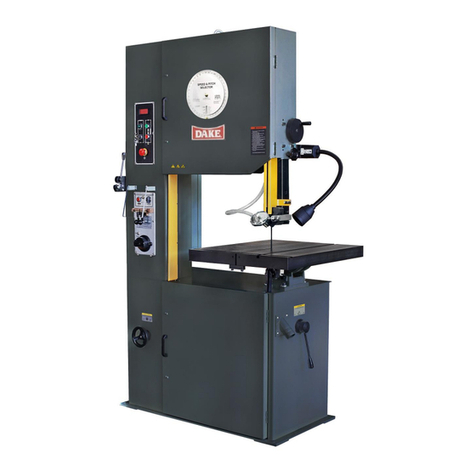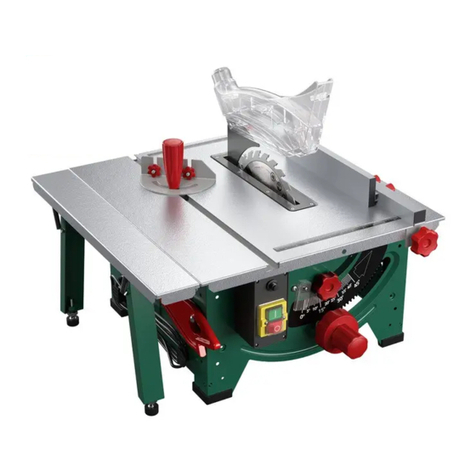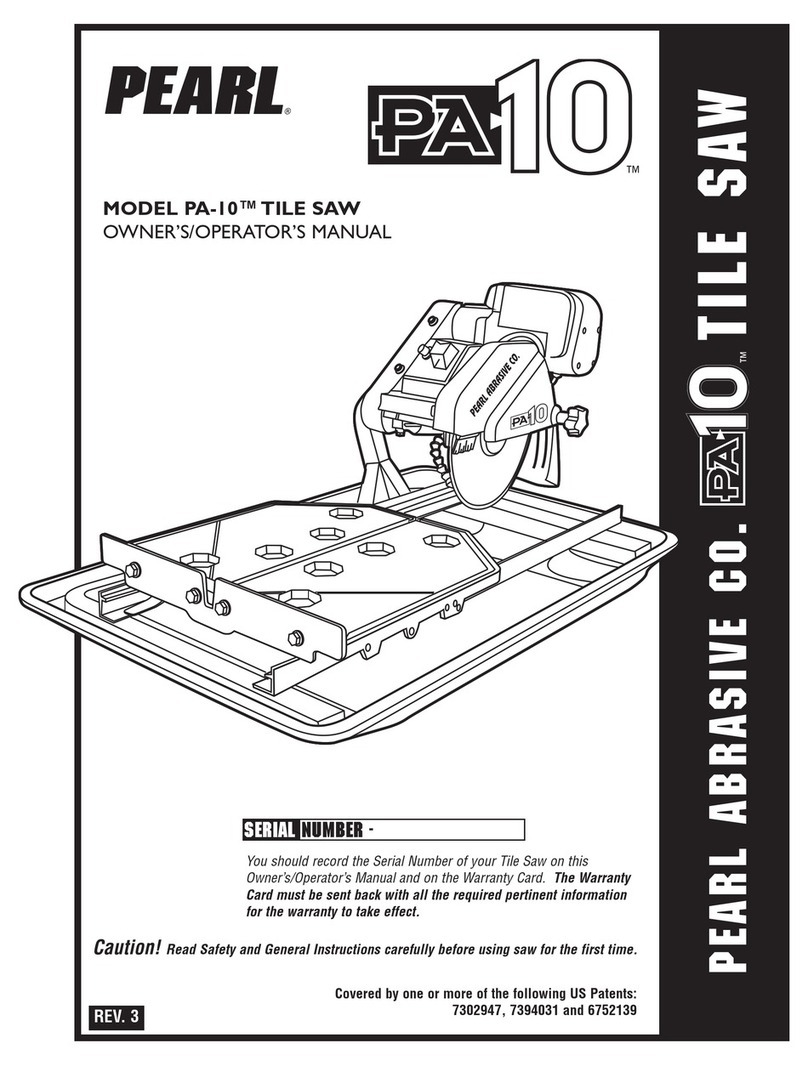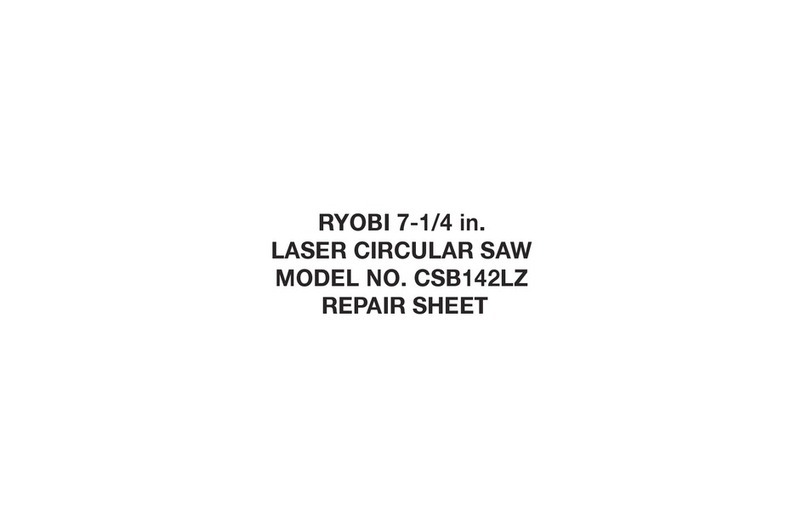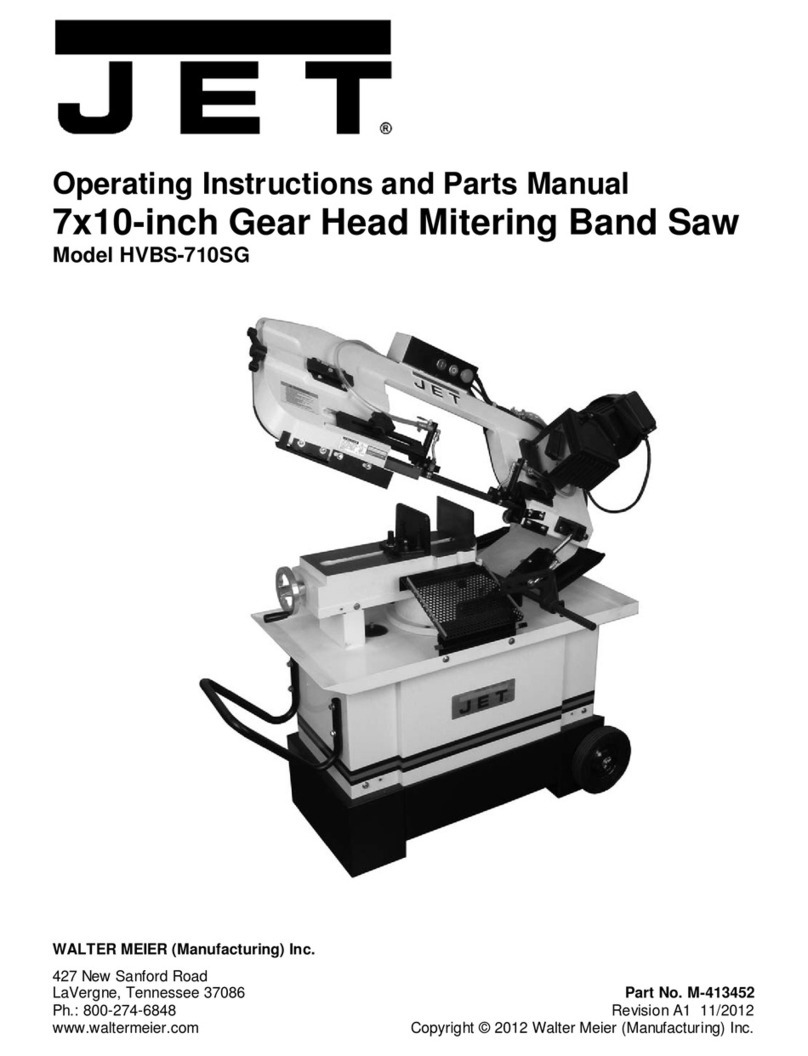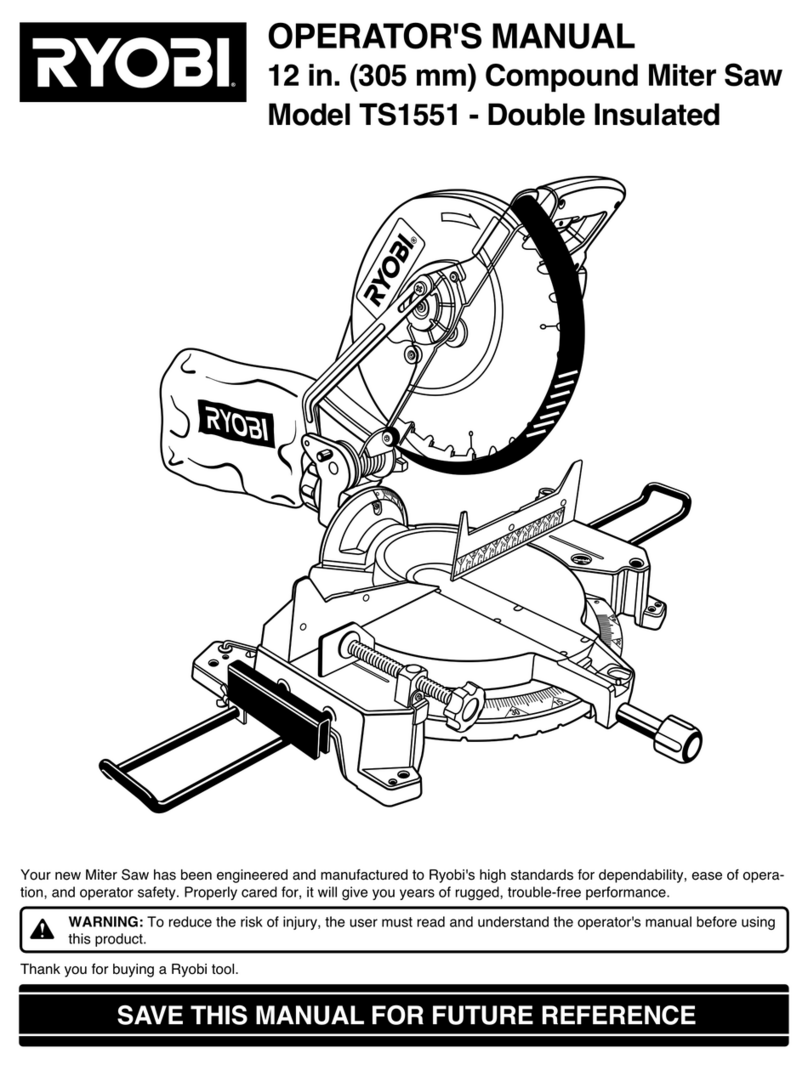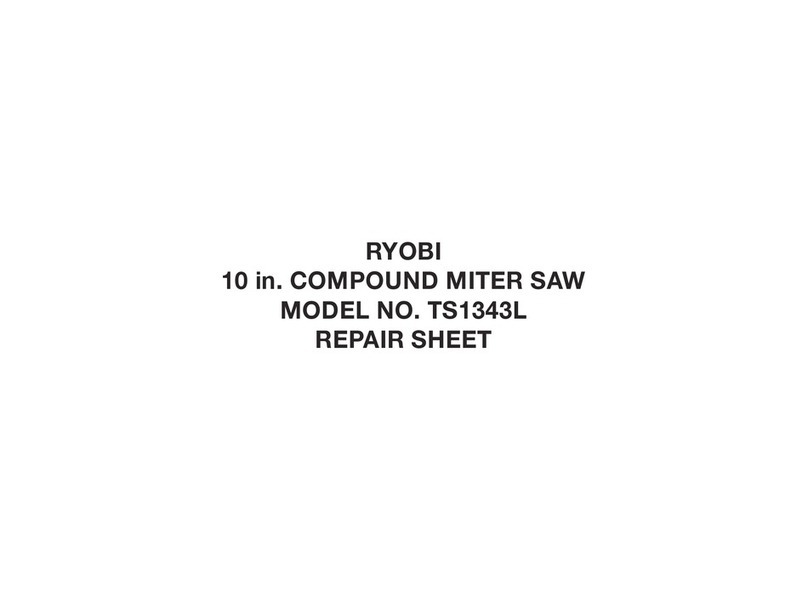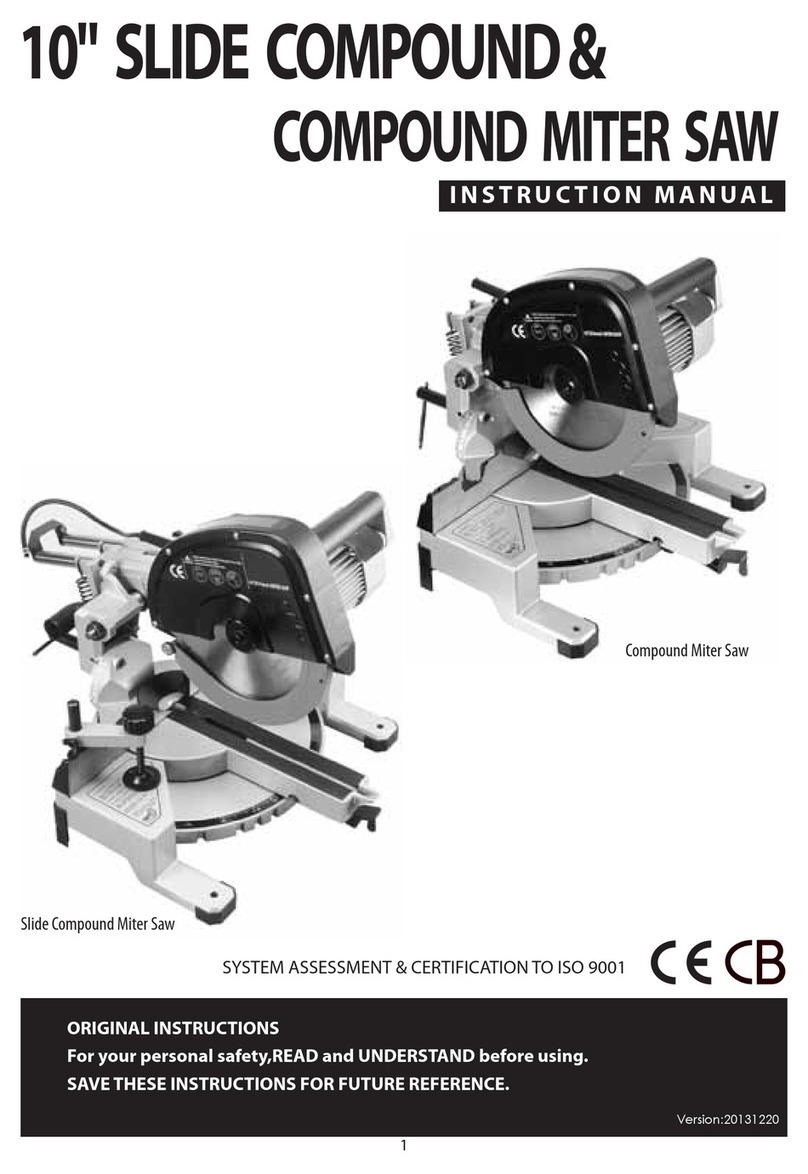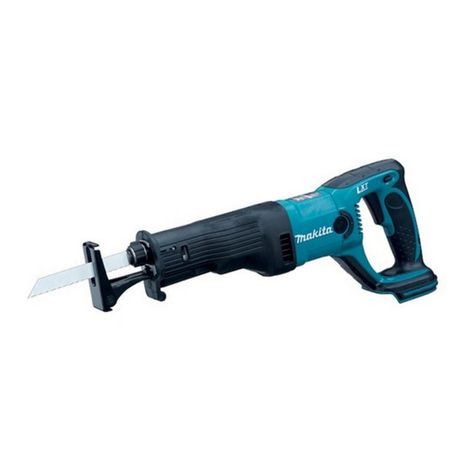Princess auto 8130239 User manual

10" Wet Tile Saw
with Stand
8
81
13
30
02
23
39
9
O
Ow
wn
ne
er
r’
’s
sM
Ma
an
nu
ua
al
l
Read and understand all instructions before use.
Retain this manual for future reference.

Specifications
• 2.5 HP, 15A, 3,450 RPM motor
• No load speed: 2,700 RPM
• 10" continuous rim wet diamond blade for tile cutting
• Includes submersible water pump with filter, stand with wheels, and water reservoir with drain
• 45° mitre block and 90° rip guide
Cutting capacities:
• 24" max. rip cutting length
• 16" max diagonal cutting length
• 3" max cutting depth
• 16" x 11" table
• 37-1/2" x 18-1/2" x 3" deep water tray
• 2.6 to 3.12 GPM max pump flow
Safety Information
WARNING: When using tool, basic safety precautions should always be followed to reduce the risk of personal
injury and damage to equipment.
Read all instructions before using this tool!
1. Keep work area clean. Cluttered areas invite injuries.
2. Observe work area conditions. Do not use machines or power tools in damp or wet locations. Do not expose to
rain. Keep work area well lighted. Do not use electrically powered tools in the presence flammable gases or
liquid.
3. Keep children away. Children must never be allowed in the work area. Do not let them handle machines, tools, or
extension cords
4. Store idle equipment. When not in use, tools must be stored in a dry location to inhabit rust. Always lock up tools
and keep out of reach of children.
5. Do not force tool. It will do the job better and more safety at the rate for which it was intended. Do not use
inappropriate attachments in an attempt to exceed the tool capacity.
6. Use the right tool for the job. Do not attempt to force a small tool or attachment to do the work of a large
industrial tool. There are certain applications for which this tool was designed to perform. Do not modify this tool
and do not use this tool for a purpose for which it was not intended.
7. Dress properly. Do not war loose clothing or jewellery as they can be caught in moving part. Protective,
electrically non-conductive clothes and non-skid footwear are recommended when working. Wear restrictive hair
covering long hair.
8. Use eye and ear protection. Always wear impact resistant safety goggles.
9. Do not over reach. Keep proper footing and balance at all times. Do not reach over or across running machines.
10. Maintain tools with care. Keep tools harp and clan for better and safer performance. Follow instructions for
lubricating and changing accessories. Inspect tool cords periodically and if damaged, have them repaired by and
authorized technician. The handles must be kept clean, Dry and free from oil and grease at all times.
11. Disconnect power. Unplug tool when not in use,
12. Remove adjusting keys and wrenches. Check that keys and adjusting wrenches are removed from the tool or
machine work surface before plugging it in.
13. Avoid unintentional starting. Be sure that the switch is in the off position when not in use and before plugging in.
14. Stay alert. Watch what you are doing. Use common sense. Do not operate any tool when you are tired.

15. Check for damaged parts. Before using any tool, any part that appears damaged should be carefully checked to
determine that it will operate properly and perform its intended function. Check for alignment and bending of
moving parts; any broken parts or mounting fixture; and any other condition that may affect proper operation.
Any part that is damaged should be properly repaired or replaced by a qualified technician, do not use the tool if
any switch does not turn on and off properly.
16. Guard against electric shock. Prevent body contact with grounded surface such as pipes, radiators, ranges and
refrigerator enclosures.
17. Replacement parts and accessories. When servicing, use only identical replacement parts. Use of any other parts
will void the warranty. Only use accessories intended for use with this tool. Approved accessories are available
from your local retailer.
18. Do not operate tool if under the influence of alcohol or drugs. Read warning labels on prescriptions to determine
if your judgment or reflexes are impaired while taking drugs, If there is any doubt, do not operate the tool.
19. Use proper size and type extension cord. If an extension cord is required. It must be of the proper size and type to
supply the correct current to the tool without heating up . Otherwise the extension cord could melt and catch fire,
or cause electrical damage to the tool. If you are using the tool outdoors, use an extension cord rated for outdoor
use (signified by “WA” on the jacket).
20. Maintenance. For your safety. Service and maintenance should be performed regularly by a qualified technician.
Note: Performance of this tool (If powered by line voltage) may vary depending on variations in local line voltage.
Extension cord usage may also affect tool performance.
Grounding/Voltage Warning
WARNING: Before using this tool, make sure that the power cord will be plugged into an outlet which has a three-
prong ground, is 120V AC, is protected by a 30 Amp. circuit breaker and has a Ground Fault Interrupter.
Common household current is 110-120V. As long as the outlet used with the tile saw is rated from 110/120V there will
be no complications using it with household receptacles. Plug the tool into a 110 to 120V properly grounded outlet
protected by a 15 Amp, dual element time delay or circuit breaker.
NEVER try to plug a 110 to 120V tool into a 220 to 240V circuit, or serious complications and possible injury to the
operator may occur. The plugs have different shapes to prevent this. This tool has a three-prong plug. The third round
prong is the ground, Cutting off the ground will result in a safety hazard.
If the outlet you are planning to use is the two-prong type, do not remove or alter the grounding prong in any way.
Use an adapter and always connect the grounding plug to known grounding source. It is recommended that you have a
qualified electrician to replace the two prong outlet with a properly grounded three-prong outlet.
Extension Cords
Your tool has a three-prong plug, therefore you must use a three-prong extension cord. Only use rounded jacket
extension cords listed by the UL. Improper use of extension cords may cause inefficient operation of your tool which
can result in overheating. Be sure your extension cord is rated to allow sufficient current flow to the motor. If you are
using the tool outdoors, use an extension cord rated for outdoor use (signified by “WA” on the jacket)

Unpacking
When unpacking, check to make all parts listed on pages 8 to 10 is included. If any parts are missing or broken, please
call your local retailer.
Notes:
• Table Stand is specifically designed for use with this 10” Tile Saw and is not included. Stand is available for
purchase from your local retailer. And table stand is packed in an individual carton,
• If the stand is not to be used with the tile saw, the saw must be securely mounted onto a flat level surface capable of
supporting the weight of the tile saw in addition to the weight of all work pieces
Assembly
1. Slide the water tank through the slot in the machine frame so that the entire tank rests inside the machine frame.
2. Mount the motor to the machine frame by connecting the supporting frame to the machine frame at the point
shown in the assembly diagram on page 10. Secure using two bolts, elastic washers and big flat washers as
shown.
3. Next, attach the blade guard to the motor using the locking knob and flat washer provided. Please note this
product does not include a blade. Please see the following section “changing/installing the blade,” for instruction
on how to properly install a new blade.
4. Plug the pump into the back of the back of the motor and attach the pump to the water tack using the four suction
feet on the bottom of the pump.
5. Slide the table holder through the middle of the rail over and fit the two inserts over the ends of the cover to
prevent the table holder from slipping out.
6. Attach the rail and table assembly to created instep 5 to the frame using two sets of the bolts. Flat washers and
both washers as shown in the assembly diagrams.
7. Before operating this tool, mount the table saw to the table stand by following the steps outlined in the assembly
and operating instructions for the table stand. IF the stand is not to be used with the tile saw the saw must be
securely mounted onto a flat, level surface capable of supporting the weight of the tile saw in addition to the
weight of tall work pieces.
Installing changing blade
1. Be sure that power cord is unplugged from it power source.
2. Loosen the locking knob located on the side of the blade guard and raise guard. Tighten in knob to lock the guard
in an “up” position.
3. Depress the brake shaft button (see fig1 on page 7) while turning the blade (or spindle if you have not yet
installed a blade) with your hand until the shaft button depresses fully. This will prevent the spindle from spinning
and allow you to unscrew the nut and outer flange
4. Slide the new blade over the spindle, and refasten the outer flange and nut, be sure to lighten the nut fully before
use.
5. Lower the blade guard and tighten the locking knob.

Installing water supply
To prevent excessive water on the blade, be sure to maintain a continuous flow of water over the blade while cutting.
Never cut anything if the water flow is not continuous.
1. Attach the pump as described in step 4 “assembly” position the pump so it will not interfere with the motion of
the table while cutting.
2. Fill the water tank with enough water so that the pump is completely submerged, but not so much water that the
bank overflows.
Note: When using the tile saw, extreme care must be taken to insure that the saw’s power cord or contact with water
while tool is in use could cause electric shock. Care and common sense must be used in planning a safe work
area parts. Protective, electrically non-conductive clothes and non-skid footwear are recommended when
working. Wear restrictive hair covering to contain long hair. (page 4)
Operation
Preparing to Cut:
1. Place your marked tile you wish to cut and place it aside for a moment.
2. Fill the tank with water as described in “installing the water supply” above
3. Plug the pump’s power cord into power unit. Make sure the pump power cord is positioned so it will remain in a
dry location once the machine is in use.
4. When it is safe to do so, plug the power unit cord into an appropriate outlet.
5. Put on your ANSI approved eye protection.
6. Flip the power switch located on the front of the motor to the “on” position
7. Before operating the tile saw. Let the motor run for approximately one minute. Make sure the blade is rotating at
full speed and there are no unusual noises. If you feel the units is not operating properly, do not use this tool.
Cutting Tile:
1. Place your marked tile on the table and brace it against the upturned edge (fence) o the back of the table. Align
the cut mark with the blade.
2. Once the tile saw has been turned on, allow the blade to spin up to full speed. Watch to be sure that the pump is
supplying a continuous flow of water to the blade.
3. Keeping your hands clear of the blade. Move the table and the tile underneath the blade. Feed the tile underneath
the blade very slowly. Do not force it. If the rotational feed of the blade slows down significantly, then you are
forcing the tile. No spectators should be allowed in the working area.
4. While cutting. Watch to be sure that the blade remains wet. If it runs dry, check the action of the pump and the
water level of the tub.
5. If the motor stops suddenly, Up the power switch to “off” position. Wait approximately 15 minutes, remove the
circuit beaker cap located directly above the power switch, and push the reset button.

Using the parallel guide:
If you have to cut a number of tile to the same dimension, using the parallel guide may save you a significant amount
of time.
1. Mark the first tile to the correct dimension, allowing space for grout
2. With the motor turned off, place the marked tile on the table against the fence. Align the cut mark with the blade.
3. Loosen the locking knob on the parallel guide. Place the hooked portion of the guide over the upturned edge of
the table, on the side of the cutting groove where you have placed the part of the marked tile that you intend to
keep and use after cutting. The parallel guide will be parallel to the tile and perpendicular to the fence.
4. Slide the parallel guide along the fence until it abuts the tile, keeping sure that the mark on your tile remains in
line with the blade.
5. Tighten the locking knob on the parallel guide.
6. when you are satisfied that the tile is aligned with the blade, and the guide is in place, and it is safe to do so, turn
on the power switch, cut the tile as described in previous instructions.
7. Check to be sure that the tile has been cut to proper dimensions before using the parallel guide to but your other
tiles. Periodically test the fit of each tile as you continue cutting, to be sure the parallel guide has not moved.
Using the angle guide:
Use the angle guide for cutting angled edges on you tiles.
1. Attach the angle guide to the fence as you did the parallel guide, using the two locking knobs to hold the guide in
place.
2. Use the cutting groove in the middle of the table to brace the edge of your tile as you slide the tile and the table
underneath the blade
Maintenance
Always unplug the power cord before servicing and before performing any maintenance.
General Maintenance:
1. Regularly inspect the diamond saw blade. Using a dull blade will cause excessive wear on the motor, and will not
produce a satisfactory cut. Replace with a new one while needed.
2. Inspect the mounting screw on all safety covers, and the arbour nut on the cutting wheel shaft. Tighten any that
appear loose.
3. Protect the motor and electrical components from prolonged or excessive exposure to water or wet conditions.
Wipe the unit dry as needed.
4. Periodically apply a light lubricant to the rail cover.
Note. The pump is non-serviceable. If it should fail, first try cleaning the intake of debris and be sure the bale is not
plugged. If the pump still does not work. It must be replaced.

Figure 1

Parts Diagram

Parts List
No Description Q’ty No Description Q’ty
1 Washer 4 50 Connecting plate 1
2Nut 2 51 Small shaft 1
3 Water tank 1 52 Washer 1
4Elastic washer 4 53 Knob 1
5 Bolt 2 54 Screw 1
6Rubber insert 1 55 Connecting plate 1
7 Aluminum guide 1 56 Small shaft 1
8 Plastic insert 2 57 Position tube 1
9 Pressing plate 2 58 Washer 1
10 Screw 4 59 Bolt 1
11 Machine frame 1 60 Blade guard 1
12 Nut 4 61 Screw 3
13 Bolt 2 62 Rubber pad 1
14 Bolt 2 63 Bearing 2
15 Elastic washer 2 64 Inner flange 1
16 Washer 2 65 Blade 1
17 Adjusting plate 2 66 Outer flange 1
18 Carrying handle 2 67 Nut 1
19 Stand(A) 1 68 Brake shaft 1
20 Nut 2 69 Screw 2
21 Stand(B) 1 70 Brake holder 1
22 Bolt 2 71 Retaining ring 1
23 Bolt 8 72 Spring 1
24 Rolling wheel 2 73 Washer 3
25 Washer 8 74 Belt 1
26 Nut 8 75 Pulley cover 1
27 Plastic insert 1 76 Bolt 2
28 Bolt 2 77 Position plate 1
29 Bolt 1 78 Bolt 3
30 Bolt 1 79 Spindle pulley 1
31 Knob 1 80 Spindle 1
32 Big washer 1 81 Spindle sleeve 1
33 Position tube 1 82 Sliding guide 1
34 Washer 1 83 Parallel guide 1
35 Steel 1 84 Angle block 1
36 Shaft 1 85 Knob 1
37 Coach bolt 4 86 Bolt 4
38 Aluminum base 1 87 Rolling wheel 1
39 Motor adjustment bar 1 88 Bolt 1
40 Big washer 1 89 Steel plate 1
41 Bolt 1 90 Main table 1
42 Motor pulley 1 91 Tube 1
43 Screw 2 92 Retaining ring 2
44 Key 2 93 Sliding tube 4
45 Motor 1 94 pump 1
46 Nut 4 92 Retaining ring 2
47 Elastic washer 4 93 Sliding tube 4
48 Washer 4 94 pump 1
49 Screw 1
Table of contents
Other Princess auto Saw manuals
Popular Saw manuals by other brands
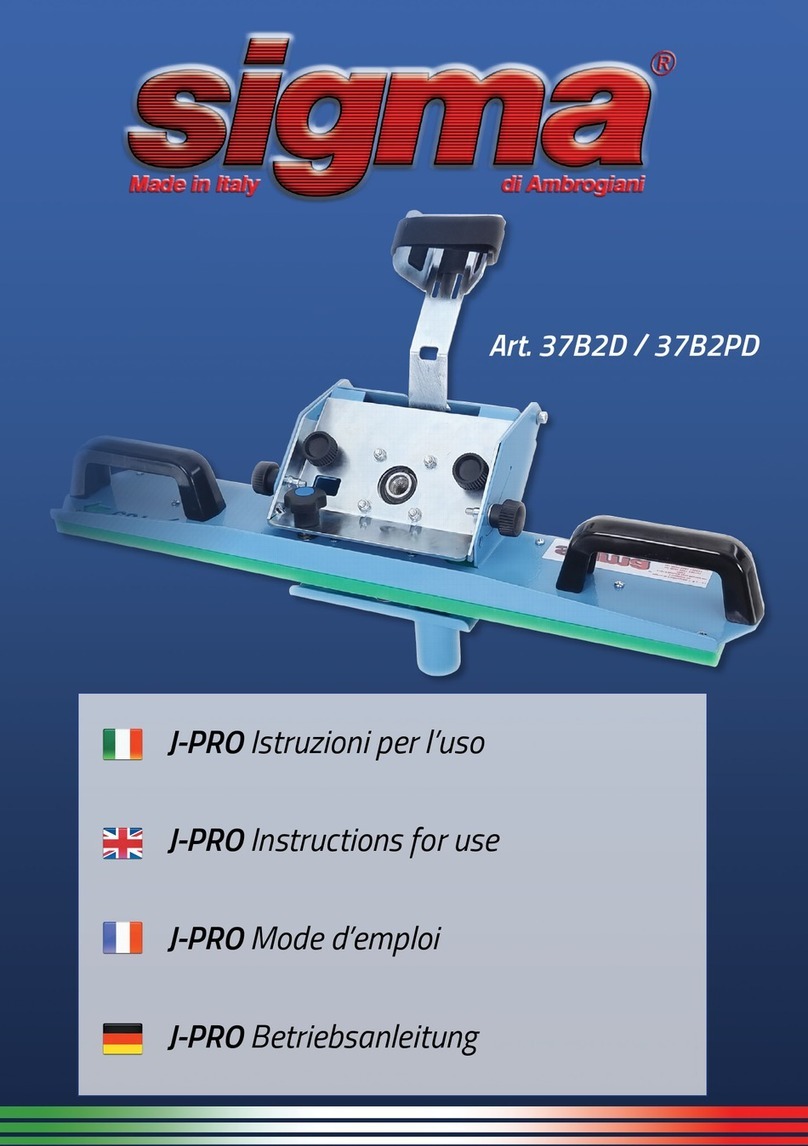
Sigma
Sigma J-PRO Instructions for use

GreenWorks
GreenWorks CRD401 Operator's manual
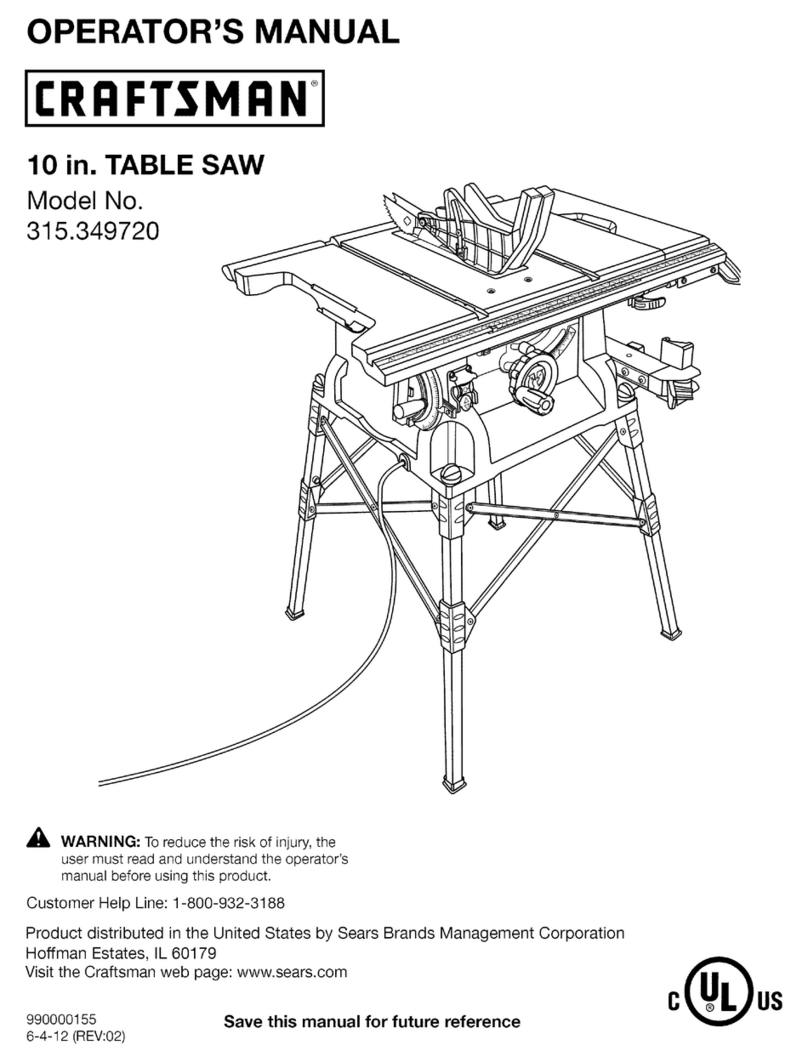
Craftsman
Craftsman 315.349720 Operator's manual
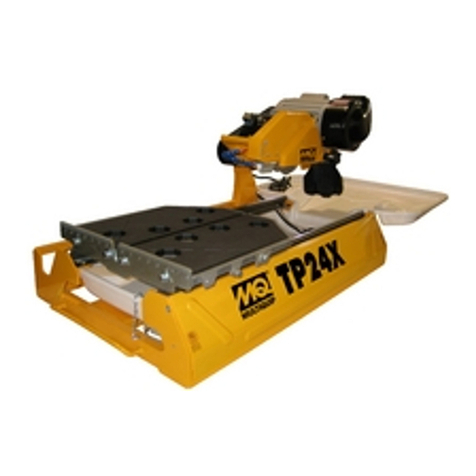
MULTIQUIP
MULTIQUIP TP24X Operation and parts manual
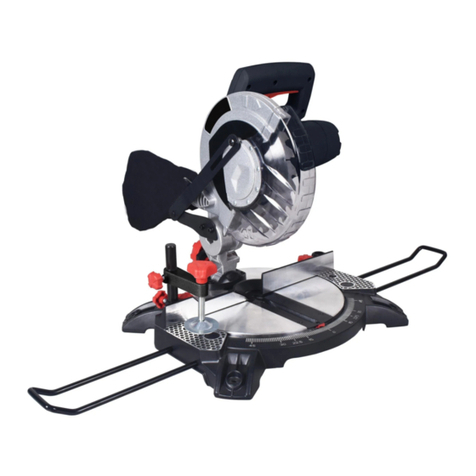
Dexter Laundry
Dexter Laundry J1G-ZPA-210D-EU Assembly, Use, Maintenance Manual
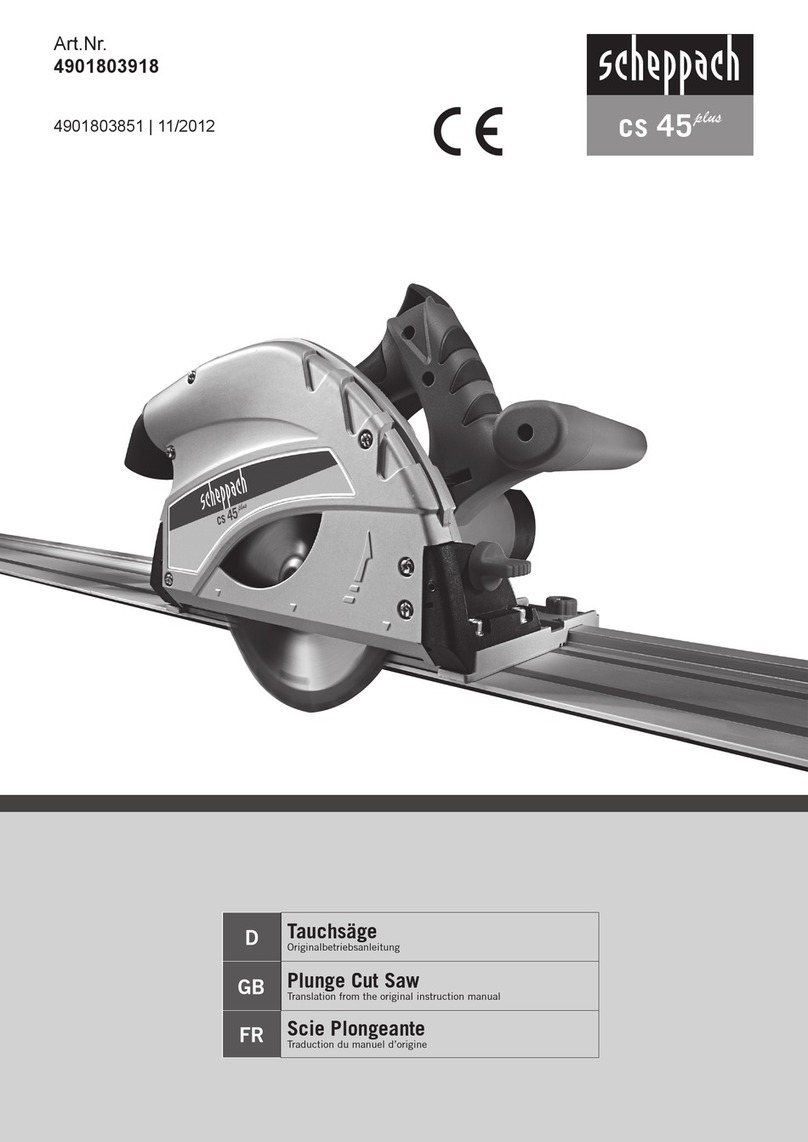
Scheppach
Scheppach CS 45 plus Translation from the original instruction manua



